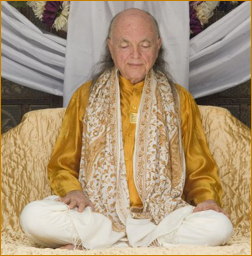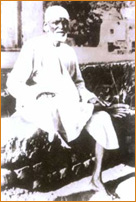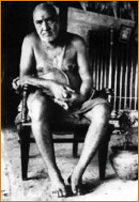A Presentation
on Money and the Guru: |
 Avatar Adi Da Samraj |
Now part of the reason a lot of us have come to Adi Da is because He doesn’t have either the ascetic or puritan disposition where somehow only certain aspects of life are allowed. But even though I mention that, there are still a lot of puritanical attitudes even in our own gathering. And that’s part of what gets us in this whole consideration about sex and this whole consideration about money. There’s still a lot in all of us that basically looks at Adi Da as an ordinary man and sees what He does with ladies and with money as what we would do with them, as what we would do if had a lot of money at our disposal or were served in a particular way. We tend to project onto Him what we would do with women if we were in that circumstance, or what women would do with men in that kind of circumstance.
So the question that comes is what is purity? What is it to be pure? What kind of state is Adi Da in? And in that we get into a whole conception about Tantra, and what has been understood traditionally in the Tantric tradition and in the Vajrayana [a form of Tibetan Buddhism], in the high traditions in which they embraced light a little more fully.
Okay. So now why does Adi Da do what He does? The first thing I want to say about money and the Guru as a basic bottom-line principle is that number one understanding of the Guru is that the Guru gives the devotee the greatest gift. The Guru gives the devotee the revelation of the Divine. And it’s always understood, and if you look at The Hymn of the True Heart-Master [Now The Ruchira Avatara Gita], the Guru is the only True wealth. Real wealth is that Revelation.
 Swami Muktananda |
The real gift is not giving some money to somebody or other. The real gift is giving that Supreme Treasure. It is a debt you can never really repay. Someone asked Swami Muktananda about the debt to the Guru, and he says, “I can never repay it. I’m at a loss to repay it.” He says, “Every time I think I’m getting close by doing something to serve Nityananda, I feel so much more grace from him I can never get close to it. I can never give him enough. There’s no way to ever give enough to the Guru, to have it repaid.” He says, “Every time I make another gesture towards the Guru, I get given more. Therefore, I’m more in debt.” He actually said, “If you can tell me a way to repay my debt to Nityananda, I will be happy. I can’t find it.”
So that basic fact, the number one fact, in terms of support of the Guru is you can never give him as much as he’s given you. And the number one obligation of devotees in relation to the Guru is to take care of the Guru’s needs. The Guru should be pleasurably dependent on his devotees. It has always been understood that way. In other words, the Guru should not be required, as He used to say, to open a candy store in Iowa, to do work for UPS.
That should not be required. The devotee should take care of the Guru. And the basic principle here relative to the Guru is that the Guru should be seen — even though the Guru can be fiery and yell and say all sorts of things — the Guru should be understood as the most sensitive, the most fragile, the most vulnerable individual who does need to be absolutely supported, taken care of. And the idea is that if you take care of the Guru so he has to put no attention on taking care of his circumstance, none whatsoever, then he can do his real work. The idea is that we totally take care of everything that the Guru might need on the level of the body-mind, so that he can do his Divine work, so that he can use every ounce of his precious incarnation for his blessing work. So that’s the number one foundation for this whole matter of giving money to the Guru and supporting the Guru.
Okay. Now a corollary to that is that if the Guru is happy, if the Guru is pleased, it’s always understood traditionally that that magnifies his blessing. In other words, the more the Guru is happy, the more blessing there is for all.
Adi Da has recently (1996) been referring to Himself as “Samraj”, which means “king of everything”. And what Adi Da is saying there — and this is something that’s very often understood in the traditions — If you’re in His Company, and you feel His Siddhi [Spiritual Power], it’s very clear to you that He is the “Master of everything.” It’s not simply He’s the Spiritual Master, but also uniquely the Source-Condition that embraces all. Everything arises within the Divine. Adi Da being the Divine, being the Source of all, everything in the world is embraced by Him. He is the Master or “King” of all. When you’re around Him, there’s this incredible feeling that everything He’s doing has an effect on everybody. But we forget it when we’re away from Adi Da — we lose that orientation. When you’re around Him and you see Him do the simplest thing, like re-arranging the art in His room, there’s the feeling that He is basically rearranging the world. And the point is that when He talks about Himself as "Adi Da Samraj", He is pointing to a demonstration in His own body that affects everyone. In other words, He’s doing a Blessing Work to affect everyone. And His demonstration is not the demonstration of Jesus on the Cross, the ascetic who makes the sacrifice. His demonstration is the Blessing demonstration. It’s the Fullness demonstration. It’s the Divine at Pleasure.
So the more we can give to the Guru so he can make that demonstration, the more that Blesses the whole world, because his Siddhi is doing that. This is all a very spiritual orientation, but it is how it’s understood.
It’s basically said that the Guru looks upon money like a tiger looks upon grass — it doesn’t mean anything to a tiger. A tiger can’t eat it. He’s interested in hunting. Grass means nothing to him. To a cow it’s another matter. To a tiger it means nothing. Money means nothing to the Guru in that sense. It’s a matter of him using money and using it to do that fullness work. And everything you look at, it’s a matter of not simply him working with that particular object but working with blessing everyone and everything.
Adi Da is associated with an art collection, and it’s about happiness. For Him, it is not "owning" art (He doesn't: He's a legal renunciate), it’s a matter of Him infusing the happiness in everyone through the happiness the collection gives. In other words, what’s experienced in the microcosm of the Guru’s body affects the macrocosm of everyone and everything. And this is also understood in the tantric tradition.
 Shirdi Sai Baba |
Sai Baba of Shirdi used to use coins. And through using these coins that represented his devotees, he affected everybody. He would rub these coins and that would affect his devotees. Adi Da uses all those around Him, but He uses everything to affect everything else. So everything that’s given to Him He uses. Have you ever noticed how Adi Da embraces everything? Why does He do that? It’s His Work, you see. He’s affecting people. His doing things has a great effect on people who also relate to those things. You can’t ultimately understand or interpret it.
But there is a process understood in tantra. The basic idea of tantra is that you use ordinary means or the things that ordinarily are not considered to be spiritual. And instead of using them for the ordinary purposes, you use them for spiritual purposes, and therefore those things are transformed, particularly things like the traditional five m’s noted in tantra [mudra/grain; matsya/fish; madya/wine; mamsa/animal flesh; maithuna/sexual union]. Relative to the tantric Guru, the bigger the Guru can do it, the more energy there is, the better it is.
The more money Adi Da has, the more Work He can do. He’d rather work with millions. If He can work with millions, it’s easier to affect the six billion beings in the world.
Adi Da once said to us, “It’s easier to reduce your involvement in enterprises of ordinary life and to restrict your budget than it is to be greater than that. To succeed, you must control spending, but you also must succeed.” And so He wants us to succeed so there’s more, bigger, more fullness. “No man needs nothing.” — the line that He loves from the movie Lawrence of Arabia. The bigger the better, because He can affect more, His incarnation can be used more fully.
I want to read something about this matter of the Raja Guru — “raja” means “king”. “The Raja Guru. The Raja Guru or the Raja Yogi is the Guru who acts like a king.” I want to give people a little bit more of a traditional understanding about that, because it’s not something that’s just simply unique to Adi Da.
 Upasani Baba |
Upasani Baba says that if a Sat-Purusha [highly realized Saint] has devotees who have worldly tendencies, then the Sat-Purusha may assume the qualities of “king” or “raja” in order to absorb these. Beloved Adi Da, You have instructed us relative to You, spontaneously and without any necessary intention acting in such a manner that is always Liberating or Freeing all beings. You have appeared at the end of the Kali Yuga, in which worldly tendencies are at a maximum. Therefore, You are in Your Perfection, Adi Da Samraj, the sultan, the rajeswari, who for the sake of his devotees must be treated as a supreme king. You absorb the worldly qualities of Your devotees through Your spontaneously manifested Tapas.
This is from a talk given by Upasani Baba in 1924:
|
Some saints are raja-yogis. They always remove the accumulating merit that is likely to give sinful pleasures or to add on to your sins, and in return they give the good grace that leads to real happiness. [James: In other words, they take away things. He's even talking about taking away all sorts of opportunities for indulgence.] Such individuals are seen to live in the world in a princely style. But mind you, all these pleasures . . . do not affect them in terms of their realization. It is their destinies to live like princes. A man liberated from the chains of births and deaths is liberated from them only when he is fully devoid of not only negative karma but also of positive karma as well. This place not only takes away your sins, but takes away all the positive things that are likely to give rise to sin and sinful pleasures. And it is due to this that we people who do so are always seen to be full of suffering and pain. [James: In other words, the Guru has to take it into himself.] The raja-guru and the dukha-guru, the ascetic guru, look as opposites to each other in every way, but remember they are not separate. They are the same. Godamastu, ed., The Talks of Sadguru Upasani-Baba Maharaj, Vol. II |
And Upasani Baba continues:
Mr. Nikadhikar, who left this place a couple of days ago was a descendent of a saint named Raghunatha Swami. [James: Raghunatha Swami was a saint who lived in the eighteen hundreds who was treated like a king and was surrounded by lots of women and a big durbar [royal court] — in other words, lots of money, lots of gold, like a court. So He’s talking about him. He’s one of the examples for Upasani Baba of the raja-guru.] This Raghunatha Swami, one has to bear in mind, was a very great purusha, but he was always surrounded by luxuries.You can read about his life, but I want to tell a short story about him. “The swamiji of course knew what was going on in the mind of the brahmana. Since the brahmana had come all the way from Kashi [another name for Benaris], Swamiji decided to give him some liberation. So he suddenly ordered for dinner to come. Immediately beautiful silver dishes were produced for everybody containing articles of sumptuous food. Swamiji ordered a dish for the brahmana and requested him to dine. The brahmana had not had his bath [You’re supposed to have a bath before your meal if you’re a brahmana.] But the Swamiji asked him not to worry about that much sin and just allured him to dine. The brahmana was allured, and he had a meal. Pan [which is kind of like betal nut that is chewed afterwards] was served at the end of the dinner. The brahmana was now seated in comfort, and Swamiji enquired after him. “The brahmana said, ‘I heard about your greatness and your fame and arrived here for your darshan, but I am deceived. There are no signs of a sat-purusha to be seen here. Being a resident of the banks of the Ganges [because he lived in Benares, in Kashi] it pains me to see this awful, sinful sight.’ “Swamiji said,
‘Well if things here are that sinful, please show me the way to liberation.’ “The Swamiji at once took 2 loincloths and requested the brahmana to guide him now. The brahmana started out in front and the Swamiji was behind, and that is how the procession started. The devotees asked Swamiji about his going, to which he replied, he would not be going anywhere. Don’t worry. He would be returning shortly. “The Swamiji began to walk too fast, and poor brahamana could not keep pace with him. He remained behind nearly a couple of miles. “At this very time, there was a king passing with all of his retinue. The advance party of the king saw the Swamiji and recognized him. And one of the party ran to the king and told him about the Swamiji being there. Well the king at once hurried to the place and ordered tents to be pitched. And in a few minutes, Raghunath Swami was again seated on a luxurious bedstead surrounded and served by the royal family. By this time, the brahmana arrived at the spot and began to enquire if such and such a swami wearing a loincloth was seen on the way. Somebody told him the Swamiji was sitting in yonder tent. The brahmana went there and found the Swamiji exactly in the same situation as his place in the first place. “Swamiji called the brahmana and recommended him to the king. The king ordered his minister to look after the brahmana, and a few hours later the Swamiji said to him, ‘Well my dear brahmana, shall we proceed again?’ “The poor brahmana was in a dazed state. He could not understand what had happened. Swamiji further said, ‘I left my permanent place and my comforts and started with you. How can this temporary luxurious state decay me now. Come on, let us go ahead as settled.’ “The poor brahmana was now in all confusion. Seeing that, Swamiji explained to him, ‘My dear brahmana, I am in the state of only. Things come to me and go away from me spontaneously. You have at least a loincloth of your own with you. I don’t even have that. [James: In other words, he is a renunciate. He really doesn’t own anything. Things just come and go all the time.] In short, whether in princely or beggarly surroundings, a sat-purusha always does good by the world. Whichever way you go, the Ultimate is the same.” Godamastu, ed., The Talks of Sadguru Upasani-Baba Maharaj, Vol. II |
Then he says:
If you want to see an example of how Raghunatha Swami was living, today go and see a well known sat-purusha, Narayan Maharaj of Kedkaon. Apparently he seems like a prince, to be enjoying the estate of his forefathers. |
Adi Da loves to tell a similar kind of story about this man who comes into a palace and sees this great sadhu, who's a king, sitting there with all these women and all this luxury. And he says, “I don’t understand how you can do this and maintain your liberation.” And so the man says, “Well, listen, let me give you a tour of the palace. You can see everything. You can go into the harem. You can look at everyone.” He says, “But one condition.”
He says, “Yes, whatever the condition, I’ll take that condition.”
The king says, “The one condition is I’m going to have you followed. I want you to carry a bowl of water, and I’m going to have followed by a man with a sword. And if one drop of that water goes out of that bowl, I’m going to have your head chopped off.
And so they do it. The man goes around, and when they come back to the king, the king says, “Well, how did you enjoy my palace, and how did you enjoy the harem and everything else?”
He says, “I didn’t see a thing.”
The king says, “What? You didn’t see anything?
He says, “I was so concentrated on the water not falling out, I didn’t notice anything.”
The king says, "Likewise, I am so concentrated on the Divine that I don't notice the palace." Adi Da pointed out how there’s all these stories about realizers who are not in the same condition as the ordinary person. So Adi Da, or a true realizer, is there apparently with women, with money, and all that. But it’s not being used for the same thing. He’s a realizer. He’s not an ordinary man.
There's a famous story — you can see it in twenty different versions — it’s a teaching story. The disciple says to the Guru something like, “Why can you act this way and I can’t.”
And the Guru says, “That’s fine if you don’t understand that. Why don’t you just do everything I do?”
So he takes the disciple into the tavern and they start drinking — the Guru starts drinking, the disciple starts drinking. And the disciple says, “See, I can do what you can do.” And then they go to the brothel and enjoy all the women and so forth. And then the Guru takes him up to the second floor and they enjoy the beautiful view. And then the Guru jumps out the window. And then the Guru looks up at him when he’s on the ground and he says, “Why don’t you jump?”
And he says, “That’s where I stop.”
So if you can’t really do everything that the Guru does, why do you think you can pick and choose just what you want to emulate? So it’s based on a spiritual understanding.
Okay, so we’re talking about the raja-guru. Would it be useful to read some more stories about realizers who lived in luxury? Well, I’ll read one of them. I’ll tell you why I want to read it. Because sometimes we can tend to think conventionally about Adi Da asking for his devotees or supporters to provide money for Him so He can do His Work on a big scale.
Let me read you about a man named Manek Prabhu who lived in India from 1817 to 1865:
|
Manek Prabhu lived like a king of kings. He held darbar [the darbar is like the court]. Thousands of visitors of all castes and communities, including Mohammedans, Parsis, Christians thronged there for his darshan. Many chose to stay with him. Shastris, pandits, artists, singers, dancers, kirtankaras, sadhus attended him, attended the darbar, displaying their respective arts, proficiency, and skill before the Guru. He used to bestow on those that he liked sumptuous gifts, gold coins, diamond rings, necklaces, and precious articles as tokens of his grace. He used to spend three to seven days in such a darbar. Once the Sri Shankara of Sringiri visited Manek Prabhu. Magnificent preparations were made for his reception. A diamond necklace and a crown full of jewels were specially prepared for offering to the Shankaracharya. Sri Manek Prabhu received him personally. A decorated elephant with a golden seat was ready for the procession. Silver and gold coins were heaped around the seat. The Shankaracharya was overwhelmed with wonder at this fabulous reception. |
Imagine a Guru so wealthy that he could give those kinds of gifts. He had so much, so much excess, that every time he had court, there were constant people, and he could give them gold and silver constantly.
And one of my favorite stories like this is a man named Samartha Ramdas, who lived in the seventeen century, the sixteen hundreds. His disciple was named Sivaji. Sivaji had one of the greatest kingdoms at that time. He had a whole Maharastra kingdom, the whole west of India was under him. And he went to Ramdas and he bowed at his feet and he gave him his whole kingdom. He says, “It’s yours. All this wealth, all this population, it’s yours.”
This man was a realizer. And this man said, “Fine. Now I give it back to you, to rule in my name. But it’s mine.” And then he said, “If I ever need anything, you give it to me.” And any time he’d want to establish a temple or something, he would ask Sivaji. And Sivaji would give him one-hundred twenty-one villages, all the revenue from them, all the tax from all those people, to establish a temple. And that’s what it was like in terms of the way the Guru was taken care of. No concern about money. Whatever he wanted, whatever he needed, just give it to him. “How many villages do you need the revenue from? It’s yours.”
 Anatha Pindaka at the feet of Guatama Buddha |
And this is the great tradition, the great tradition of patronage. Anatha Pindaka is the great patron of the Buddha. In the the first year of the Buddha’s realm, he just hears, just hears in his ear, that the Tathagata, the God-born one, the Realizer, is alive. He’s totally blown out, just hearing the words, the world-teacher — just hearing those words, it just excites him no end, just that he’s alive. Then he hears that he’s coming to his town. He immediately goes to the prince, and he has to have the pleasure grove. The prince refuses to sell the pleasure grove to him. You know, “It’s my pleasure grove.” He said, “I need it for the world-teacher. I have to have the pleasure grove. I’ll offer you 18 million for it." The prince says, “No, I won’t accept the 18 million. You have to take the 18 million and go and spread it out over the land, and then you have to put another 18 million over the next parcel, until you cover the entire parcel with 18 million. Anatha Pindaka says, “Fine.” That’s a true story, by the way. And Anatha Pindaka says fine, and he buys it. And the prince is so taken by this that he establishes the big tower of the monastery. And after he does it — he was a banker, Anatha Pindaka. The word means “the patron of the wealthy”. See, Buddhism was patronized. Then after the prince does this, other wealthy men in the town hear that the Buddha is coming. And they go to Anatha Pindaka, and they say, “Can we buy it from you? We want to have the opportunity to give it to the Buddha? We want to be the ones. Can we buy it from you?” In other words, fighting for the opportunity to give it.
So this matter of wealth and the Guru, Him asking for it, is not a new thing. It’s been typically understood. The point I’m trying to make here is the raja-guru lives in a wealthy fashion, and part of him doing that is he absorbs the karmas of devotees.
Now, another reason why he asks for so much money and does things is — first of all we talked about he just should be taken care of and have no difficulties. We talked about how the more he can work with, the more he can do his blessing work with everyone. We talked about how by asking for money and living in a more of a full style, it’s understood he absorbs karmas of devotees. So these are all different reasons why he uses money. Another reason is, actually, he intentionally — or even unintentionally, just spontaneously — is evoking a confrontation in the devotee. He is undermining the devotee. We know this one pretty well. In other words, he asks for more money and it puts you through it. He basically is doing his shape-shifting work. It’s this kind of thing that we know about the Guru, where Adi Da says:
|
What Adepts do is always paradoxical. The work of the Guru must break a spell, break an illusion. Everyone is enchanted with unreality, enchanted with the conventional appearance of every moment. And merely talking to them does not break the spell. Talk is not sufficient, because people are thinking wrongly. They are altogether associated with this moment in a fashion that renders them incapable of being awake to their actual Condition. In effect you must cut them in half with a sword. You must blow their minds. You must shake them loose. You must wholly divert them. You must trick them. To Enlighten human beings, you must be wild. You can be a friendly professorial yogi or teacher and communicate sacred or philosophical views of reality as a spiritual condition. You can point to consciousness. You can point to the mind. You can give people Yogic techniques, all of which can be done in a very orderly, gentlemanly fashion, but none of which will break the spell. Such things do not awaken people. At most they may help them harmonize their life. Conventional teaching will not break the spell of un-Enlightenment. Enlightening beings is another kind of work altogether. It is a mad work, a “crazy” work, a wild work of the Adepts. Adepts capable of this kind of work generally select the people they will serve and select a circumstance in which they feel free to work as they must. Avatar Adi Da Samraj |
One of the most astounding things with Adi Da is that He chooses to work with all His devotees this way. He if Free to be outrageous, apparently without concern for Himself. It is a tremendous thing in the “crazy wisdom” tradition about how vulnerable the “crazy wisdom” teacher is, because to teach this way invites tremendous reaction — to break the spell, to use the “sword”. Well, now does the Guru use the “sword”? You come here and He wants your money. How does he break the spell? He wants your money. See, He asks you for more. You’ve got to deal with it. And money, as we all know, is energy. It’s our energy. It’s giving over our life-force to Him. So He asks you for more. It’s pulling the rug out from under us again.
I
remember having a conversation with someone who said, “You know, I feel what Adi
Da is doing with money is very destructive. He’s destroying our community by asking
for more money all the time.” And you see, that particular attitude, where he
talks about it being destructive, there is where the sadhana is — how you respond
to the Guru when He makes demands. But part of what the Guru is doing is pulling
the rug out from under people, breaking the spell. But we
have to remember, too, that the devotee is not without responsibility.
This is Upasani Baba:
In order to elevate you to the state of God, if you are not offering anything on your own, some sat-purus has will demand of you various things. [James: In other words, if you can’t make the sacrifice, if you can’t find a way to make the sacrifice, a way that the Guru can get you to make the sacrifice is to ask you to do it. "In order to elevate you to the state of God" — That’s why he’s doing it.] Or if you can’t give him things, money in lieu of it. Sai Baba, Swami of Akkalkot and others used to demand money and other things from persons who went to them. They used to accept anything pertaining to samsara that was offered to them. To take away false things and to give back real things in return is what has been done by sat-gurus from time immemorial. You give over money, and in that gesture they can give you grace. Upasani Baba |
This is Sai Baba of Shirdi:
Always try to avoid taking anything. I always protest if somebody offers me things. But it seems that I’m destined to receive these things. Sai Baba of Shirdi |
He’s saying this because he doesn’t like the karma of having to give something back. He was always complaining about that.
 |
This is Swami Papa Ramdas, a 20th-century Indian Saint. It’s always been understood traditionally that if you give money to the Guru it’s an opportunity. So he says relative to giving money to the Guru: |
Some people say with pride, "I’ve done this or that for that saint" [In other words, "I’ve given all this money, or I did this service"], as if they’ve done a great favor to the saint by giving him money. Anybody giving anything to a saint should do it for the sake of his spiritual progress [basically understanding it spiritually] and not for the sake of obliging the saint. [in other words, I gave to him, so therefore he’s owing me for having given it to him.] There are of course some who always feel that whatever they do is for their own spiritual progress. Though all powerful, saints will sometimes show themselves to be in need, and sometimes even demand money from devotees, therefore giving them a chance to serve. Swami Papa Ramdas |
So this is another one of the misconceptions that we’ll get into sometimes. We might think that Adi Da really needs something or some circumstance in order to be happy — right? Someone can think that He was asking for something because as an ordinary man He needed it, instead of understanding everything He’s doing as part of His Work, His Blessing Work, trying to make it all right around Him so that He can Bless all.
Again, Swami Papa Ramdas:
|
So though all powerful, they show themselves to be in need, and sometimes even demand money from devotees, therefore giving them a chance to serve. When such a chance comes, and a devotee gives money to a saint, knowing that he is serving the saint for his own good, he is really benefited by such service. On the other hand, if you give something to the saint thinking that you are helping him, then you are not really considering the saint a saint. You are actually considering the saint a beggar. When people feel that a saint is in want, it means they have not understood who the saint is, but they’ve taken him to be an ordinary man going about for food. Swami Papa Ramdas |
So that’s the traditional understanding of it.
 Marpa the Translator |
There’s a great teaching story in the life of Marpa. For the sake of time I don’t think I’ll read it. But basically after a long time of collecting gold, now having a tremendous amount of gold dust, and thinking that his Guru, Naropa, was really unreasonable for asking for so much gold — he brings it to Naropa, he gives it Naropa, and Naropa’s not interested in it. He couldn’t care less. The way the story goes, Marpa basically pushes it in front of Naropa again, because he’s kind of proud of it and it’s been a big sacrifice. And Naropa takes the gold and just throws it up in the air. And the gold dust just goes everywhere. Imagine what was going through Marpa's mind at that particular moment. Thousands and thousands of dollars of gold dust just spinning up into the air — to make a teaching point — right? The way the story goes sometimes, he clicks his heels and all the money comes back together.
 Naropa |
Another version of it is Naropa doesn’t throw it up in the air but he just taps his foot on the ground and the whole ground around him all turns into gold. But it was a teaching story to show that the Guru is not in need of money in that sense. His demand of money is for the sake of evoking this change, this difference.
Now, as I say, I’m giving different reasons to understand why Spiritual Masters can seem to need so much money, or a Guru can ask for money. But there are many different interpretations. I’m just giving some of the traditional interpretations for why the Guru asks for money. So another one is that he asks for money as a demand, to evoke a confrontation, to basically blow the devotee’s mind, to force the devotee to go further, as with Naropa and Marpa.
So I want to finish this section by reading this quote from Adi Da. This summarizes His relationship to money:
One gives to the Divine because the Divine is the Divine, and because the Divine has purposes that must be served, not only by the right use of money, but by all the forms of human energy. So to give to the Guru is not to pay dues paid by a club member like a tithe. It’s not simply that. Nor is it in payment in expectation for services. The tithe and all monetary contributions are a gift to the Divine. As my devotee, you give Me this for the benefit of My Hermitage Ashram, where your True Heart-Master resides. When you tithe, it is a sacred offering you make for the sake of your relationship to Me. Because I’m a renunciate, I do not acquire anything, in that sense, just simply for Myself. But Adi Da Samrajashram exists for its own sake, for the sake of Blessing-Transmission that I’ve Established, and you tithe to this sacred Treasure. It should be obvious that I exist and the vehicles of My Work exist for the sake of everyone. Your financial support is your sacred obligation. Find a way to participate with real energy. Fulfill your commitments and do not abandon them. Every individual practitioner of the Way of the Heart is responsible for his or her relationship to Me personally. If you want to make use of My Appearance here, align yourself to Me responsibly. And such alignment is not just a fanciful matter that occurs in the mind. It is a great event, and it is part of the physics of the universe. Therefore, I advise you to take your Spiritual life in My Company seriously. And as my devotee, your practice is total surrender of the body-mind into the Divine Spirit in My Company. Therefore, understand that the significance of money is a bodily contract, a contract between you and the Transcendental and Inherently Spiritual Divine. Participate with Me in intimacy with Me. Participate from the point of view of your own environment, rather than the point of view of a club member who stands at a distance. “In the Way of the Heart, all monetary gifts serve the Spiritual purposes to which you are committed with Me. They allow Me to do My Work. [James: That’s kind of the bottom line of it.] Your financial obligations are a Spiritual matter, not just a financial matter. All that I mean by the term "money", which includes life, energy, love, work, and commitment, is the resource for the movement of My Work into the world. Through your gifts of money, you are expanding My Capability to have an Influence in the world. Avatar Adi Da Samraj |
Related quotes from Adi Da since the time James originally gave this presentation:
Money Must Become Associated With Light. Your Participation In The money-Dimension Of life Must Be Part Of Your Whole-bodily-Responsive Delight In Me. Therefore, Your Involvement With money Must Be Transformed Into Real and True Devotion To Me — Just As In The Case Of Every Other Aspect Of Your life-activity. Such Right Involvement With (and Right Management Of) money Is Part Of The Responsibility You Must Assume For Your own life (Both In The personal Context and In The Collective Context) When You Become My Formally Practicing Devotee. Thus, For My Devotee, money (and food, and sex) Must Become An Expression Of The Total Commitment Of Life's Energy and activity To Counter-egoic Practice and The ego-Transcending Demonstration Of Love. Avatar Adi Da Samraj, Sutra 31 of The Dawn Horse Testament |
I am looking to convert the course of money and energy and power in the "world" away from egoic purposes and make it flow like a river toward the Divine. This is My Work with the Divine Goddess, the Energy of Existence Who is "Husbanded" by Me and One with My Divine Being. I am Working to make this 'Husbanding" real at every level of the conditional reality. This is what My Universal Blessing-Work is about — to bring into manifestation what I have already Accomplished in seed-form. A far greater force of "conductivity" and "Invocation" — beyond the presumed limits of the physical reality and the ordinary mind — must occur. Avatar Adi Da Samraj, December 3, 2000 |
![]() For
stories illustrating some of the points communicated in this article about the
esoteric nature of money in the Guru-devotee relationship, click
here.
For
stories illustrating some of the points communicated in this article about the
esoteric nature of money in the Guru-devotee relationship, click
here.
| Quotations
from and/or photographs of Avatar Adi Da Samraj used by permission of the copyright
owner: © Copyrighted materials used with the permission of The Avataric Samrajya of Adidam Pty Ltd, as trustee for The Avataric Samrajya of Adidam. All rights reserved. None of these materials may be disseminated or otherwise used for any non-personal purpose without the prior agreement of the copyright owner. ADIDAM is a trademark of The Avataric Samrajya of Adidam Pty Ltd, as Trustee for the Avataric Samrajya of Adidam. Technical problems with our site? Let our webmaster know. |
